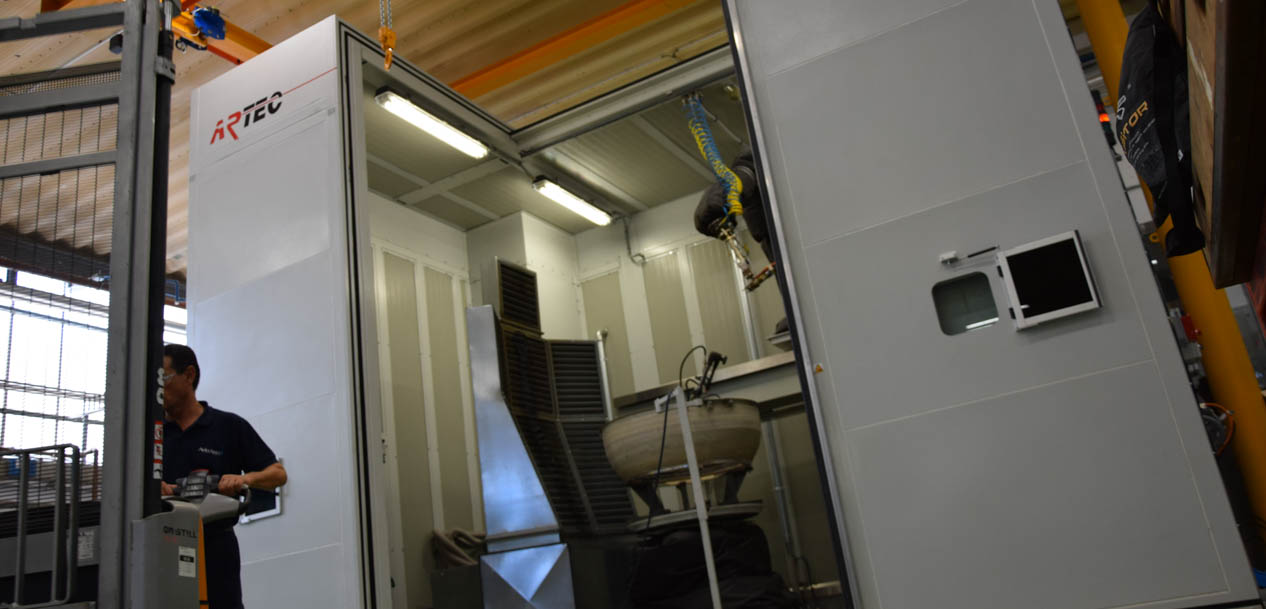Invent
Open Sesame!
The first additive repair techniques under development in Italy’s Apulia Region are already being adopted in the factory – such as in Brindisi, where one special machine does the job of three.
Jul 2017
There is no sign of a slowing in the pace of innovation at the Avio Aero Brindisi plant (the brilliant manufacturing one). The end of April saw the installation of a new large multicoating machine, so-called because it uses no fewer than three different Thermal Spray technologies. These processes used to be carried out by three different machines, which took up much more space.
The machine, which has large L-shaped automatic doors about 5 meters high, went into operation at the beginning of May and has already gained approval for the use of 13 powder coatings: the first components processed were a Rear Case of the GE LM2500 gas turbine and a Multi Vane LPC (Low-Pressure Compressor) of the RB199 military engine. The aim is to achieve approval for 37 metal and metal alloy powder coatings by the end of October.
The new machine works by an additive repair technology, because it adds powdered metal to parts, missing fragments or surfaces of aviation engine components or modules. At present, for example, tests are ongoing on the case of the LEAP engine, but the plant's large size means it can even handle the largest civil aviation engine LPT cases: like that of the GE9X, 220cm in diameter. It can also deal with particularly tall components, such as the HPC (High-Pressure Compressor) of the LM2500 aero-derivative turbine, about 1.32mt in height, or the frame of the LM600 industrial turbine, which weighs 650kg.
“This new plant is so versatile," explains Alessandro De Gioia, Brindisi Repair CoE Leader, "that it gives us an immediate competitive edge in terms of repair technique costs and quality. Not to mention the major business opportunities it offers us, such as the large case of the LM2500 gas-turbine or repairs on the cases of the GEnx and the LEAP, in the future. Last but not least, this versatility and user-friendliness allow workers to maximize the department's efficiency without neglecting their safety."
Specifically, the multicoating machine performs 3 types of “reconstructive” techniques: traditional plasm spray coating, High Velocity Oxygen Fuel coating (HVOF, the coating system for the extremely high-speed reconstruction of parts we have already seen in the CRO area at Pomigliano) and flame spraying, which applies the metal powder to the relevant parts with the aid of heat. This machine will be able to perform cold spraying, a repair technique now under development at the Bari Additive Repair Center, in the near future. The machine switches easily amongst the three Thermal Spray techniques thanks to the 5 torches (the large guns of different sizes which "spray" the metal powder) included in the system. “From the technological point of view, the biggest benefit is that we now have the capability to industrialize any component, of any size,” says Matteo Rizzo, NPI Repair Engineer. "Furthermore, in September we will be installing a new rotary torch, allowing us to spray diameters on parts without axial symmetry.”
At Brindisi, as well as at all the other Avio Aero plants, technologies are constantly being tested and developed to get prepared for industrialization, and practices and processes are shared with the "sister” plants and also with GE Store, the extended network of GE family factories. Italy's Apulia Region typifies this approach: spray and laser deposition techniques are developed in the laboratory on the Politecnico university campus in Bari, while processes are applied and industrialized at Brindisi.






